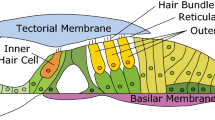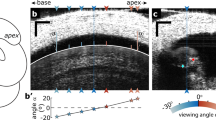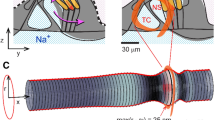Abstract
The cochlear travelling wave is fundamental to the ability of the mammalian auditory system to resolve frequency. The seashell-shaped outer bone of the cochlea (the auditory inner ear) contains a spiral of cochlear fluid and the sensory tissue known as the cochlear partition. Sound travels down the ear canal to the eardrum, causing its flexible tympanic membrane to vibrate. This vibration is transmitted to the cochlea via the ossicles. Motion of the stapes (the stirrup ossicle) sets the cochlear fluid in motion, which in turn sets the cochlear partition near the stapes in motion. The motion of the cochlear partition ripples down the cochlear spiral as a travelling wave, stimulating the cochlea's sensory hair cells. The wave peaks near the base (the stapes end) of the cochlea for high frequency tones and near the apex for low frequencies1. The fundamental elements of the cochlear travelling wave are fluid pressure and motion and partition forces and motion. However, the wave's direct experimental study has to date relied almost solely on measurements of the partition motion. Here I report finely spaced measurements of intracochlear pressure close to the partition, which reveal the fluid component of the cochlear wave. The penetration depth of the wave is very limited, ∼15 µm. Over a range of frequencies at least an octave wide, the depth is independent of frequency.
This is a preview of subscription content, access via your institution
Access options
Subscribe to this journal
Receive 51 print issues and online access
$199.00 per year
only $3.90 per issue
Buy this article
- Purchase on Springer Link
- Instant access to full article PDF
Prices may be subject to local taxes which are calculated during checkout





Similar content being viewed by others
References
von Bekesy,G. Experiments in Hearing (McGraw Hill, New York, 1960).
Olson,E. S. Observing middle and inner ear mechanics with novel intracochlear pressure sensors. J. Acoust. Soc. Am. 103, 3445–3463 (1998).
Brownell,W. E., Bader,C. R., Betrand,D. & de Ribaupierre,Y. Evoked mechanical responses of isolated cochlear outer hair cells. Science 227, 195–196 (1985).
Liberman,M. C. & Dodds,L. W. Single neuron labeling and chronic cochlear pathology. III. Stereocilia damage and alterations of threshold tuning curves. Hear. Res. 16, 55–74 (1984).
Spoendlin,H. Innervation densities of the cochlea. Acta Otolaryngol. (Stockh.) 73, 235–248 (1972).
Müller,M. The cochlear place-frequency map of the adult and developing mongolian gerbil. Hear. Res. 94, 148–156 (1996).
Dancer,A. & Franke,R. Intracochlear sound pressure measurements in guinea pigs. Hear. Res. 2, 191–205 (1980).
Rhode,W. S. Observations of the vibration of the basilar membrane in squirrel monkeys using the Mossbauer Technique. J. Acoust. Soc. Am. 49, 1218–1231 (1971).
Ruggero,M., Rich,N. C., Recio,A., Narayan,S. S. & Robles,L. Basilar membrane responses to tones at the base of the chinchilla cochlea. J. Acoust. Soc. Am. 101, 2151–2163 (1997).
Lighthill,J. Energy flow in the cochlea. J. Fluid Mech. 106, 149–213 (1981).
Sellick,P. M., Yates,G. K. & Patuzzi,R. The influence of Mossbauer source size and position on phase and amplitude measurements of the guinea pig basilar membrane. Hear. Res. 10, 101–108 (1983).
Xue,S., Mountain,D. C. & Hubbard,A. E. Electrically evoked basilar membrane motion. J. Acoust. Soc. Am. 97, 3030–3041 (1995).
Cooper,N. P. & Rhode,W. S. Basilar membrane mechanics in the hook region of cat and guinea-pig cochlea: Sharp tuning and nonlinearity in the absence of baseline position shifts. Hear. Res. 63, 163–190 (1992).
de Boer,E. Auditory physics. Physical principles in hearing theory. II. Phys. Rep. 105, 141–226 (1984).
Steele,C. R. & Taber,L. A. Comparison of WKB calculations and experimental results for three-dimensional cochlear models. J. Acoust. Soc. Am. 65, 1007–1018 (1979).
Plassman,W., Peetz,W. & Schmidt,M. The cochlea in gerbilline rodents. Brain Behav. Evol. 30, 82–101 (1987).
Acknowledgements
I thank H. Nakajima, E. de Boer, L. Sohn, N. Cooper, S. Staggs, R. Brawer, R. Austin and L. Page Jr. This work was supported by the National Institute on Deafness and Other Communication Disorders.
Author information
Authors and Affiliations
Corresponding author
Rights and permissions
About this article
Cite this article
Olson, E. Direct measurement of intra-cochlear pressure waves. Nature 402, 526–529 (1999). https://doi.org/10.1038/990092
Received:
Accepted:
Issue Date:
DOI: https://doi.org/10.1038/990092
This article is cited by
-
Cochlear motion across the reticular lamina implies that it is not a stiff plate
Scientific Reports (2022)
-
Intracochlear distortion products are broadly generated by outer hair cells but their contributions to otoacoustic emissions are spatially restricted
Scientific Reports (2021)
-
Voltage readout from a piezoelectric intracochlear acoustic transducer implanted in a living guinea pig
Scientific Reports (2019)
-
Simultaneous Intracochlear Pressure Measurements from Two Cochlear Locations: Propagation of Distortion Products in Gerbil
Journal of the Association for Research in Otolaryngology (2017)
-
Mechanical model of organ of Corti
Applied Mathematics and Mechanics (2017)
Comments
By submitting a comment you agree to abide by our Terms and Community Guidelines. If you find something abusive or that does not comply with our terms or guidelines please flag it as inappropriate.



